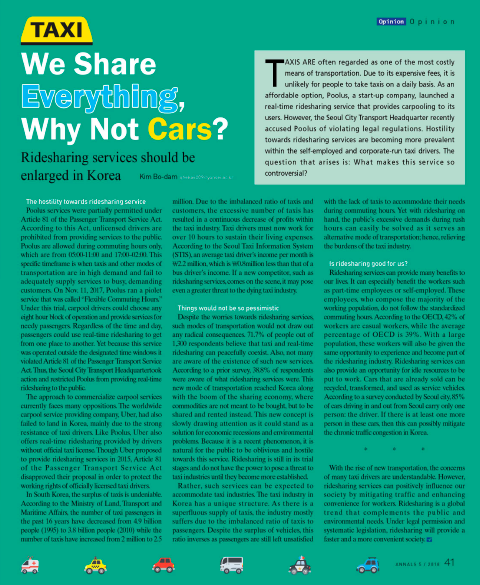Ridesharing services should be enlarged in Korea

TAXIS ARE often regarded as one of the most costly means of transportation. Due to its expensive fees, it is unlikely for people to take taxis on a daily basis. As an affordable option, Poolus, a start-up company, launched a real-time ridesharing service that provides carpooling to its users. However, the Seoul City Transport Headquarter recently accused Poolus of violating legal regulations. Hostility towards ridesharing services are becoming more prevalent within the self-employed and corporate-run taxi drivers. The question that arises is: What makes this service so controversial?
The hostility towards ridesharing service
Poolus services were partially permitted under Article 81 of the Passenger Transport Service Act. According to this Act, unlicensed drivers are prohibited from providing services to the public. Poolus are allowed during commuting hours only, which are from 05:00-11:00 and 17:00–02:00. This specific timeframe is when taxis and other modes of transportation are in high demand and fail to adequately supply services to busy, demanding customers. On Nov. 11, 2017, Poolus ran a piolet service that was called “Flexible Commuting Hours.” Under this trial, carpool drivers could choose any eight hour block of operation and provide services for needy passengers. Regardless of the time and day, passengers could use real-time ridesharing to get from one place to another. Yet because this service was operated outside the designated time windows it violated Article 81 of the Passenger Transport Service Act. Thus, the Seoul City Transport Headquartertook action and restricted Poolus from providing real-time ridesharing to the public.
The approach to commercialize carpool services currently faces many oppositions. The worldwide carpool service providing company, Uber, had also failed to land in Korea, mainly due to the strong resistance of taxi drivers. Like Poolus, Uber also offers real-time ridesharing provided by drivers without official taxi license. Though Uber proposed to provide ridesharing services in 2015, Article 81 of the Passenger Transport Service Act disapproved their proposal in order to protect the working rights of officially licensed taxi drivers.
In South Korea, the surplus of taxis is undeniable. According to the Ministry of Land, Transport and Maritime Affairs, the number of taxi passengers in the past 16 years have decreased from 4.9 billion people (1995) to 3.8 billion people (2010) while the number of taxis have increased from 2 million to 2.5 million. Due to the imbalanced ratio of taxis and customers, the excessive number of taxis has resulted in a continuous decrease of profits within the taxi industry. Taxi drivers must now work for over 10 hours to sustain their living expenses. According to the Seoul Taxi Information System (STIS), an average taxi driver’s income per month is 2.2 million, which is �.8million less than that of a bus driver’s income. If a new competitor, such as ridesharing services, comes on the scene, it may pose even a greater threat to the dying taxi industry.
Things would not be so pessimistic
Despite the worries towards ridesharing services,such modes of transportationwould not draw out any radical consequences. 71.7% of people out of 1,300 respondents believe that taxi and real-time ridesharing can peacefully coexist. Also, not many are aware of the existence of such new services. According to a prior survey, 38.8% of respondents were aware of what ridesharing services were. This new mode of transportation reached Korea along with the boom of the sharing economy, where commodities are not meant to be bought, but to be shared and rented instead. This new concept is slowly drawing attention as it could stand as a solution for economic recessions and environmental problems. Because it is a recent phenomenon, it is natural for the public to be oblivious and hostile towards this service. Ridesharing is still in its trial stages and do not have the power to pose a threat to taxi industries until they become more established.
Rather, such services can be expected to accommodate taxi industries. The taxi industry in Korea has a unique structure. As there is a superfluous supply of taxis, the industry mostly suffers due to the imbalanced ratio of taxis to passengers. Despite the surplus of vehicles, this ratio inverses as passengers are still left unsatisfied with the lack of taxis to accommodate their needs during commuting hours. Yet with ridesharing on hand, the public’s excessive demands during rush hours can easily be solved as it serves an alternative mode of transportation; hence, relieving the burdens of the taxi industry.
Is ridesharing good for us?
Ridesharing services can provide many benefits to our lives. It can especially benefit the workers such as part-time employees or self-employed. These employees, who compose the majority of the working population, do not follow the standardized commuting hours. According to the OECD, 42% of workers are casual workers, while the average percentage of OECD is 39%. With a large population, these workers will also be given the same opportunity to experience and become part of the ridesharing industry. Ridesharing services can also provide an opportunity for idle resources to be put to work. Cars that are already sold can be recycled, transformed, and used as service vehicles. According to a survey conducted by Seoul city, 85% of cars driving in and out from Seoul carry only one person: the driver. If there is at least one more person in these cars, then this can possibly mitigate the chronic traffic congestion in Korea.
* * *
With the rise of new transportation, the concerns of many taxi drivers are understandable. However, ridesharing services can positively influence our society by mitigating traffic and enhancing convenience for workers. Ridesharing is a global trend that complements the public and environmental needs. Under legal permission and systematic legislation, ridesharing will provide a faster and a more convenient society.
Kim Bo-dam
qheka6009@yonsei.ac.kr

